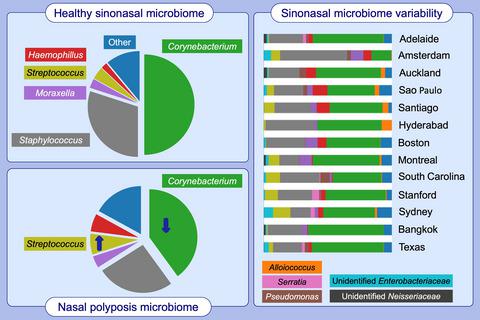Our official English website, www.x-mol.net, welcomes your feedback! (Note: you will need to create a separate account there.)
The international sinonasal microbiome study (ISMS): a multi‐centre, multi‐national characterization of sinonasal bacterial ecology
Allergy ( IF 12.4 ) Pub Date : 2020-03-30 , DOI: 10.1111/all.14276 Sathish Paramasivan 1 , Ahmed Bassiouni 1 , Arron Shiffer 2 , Matthew R Dillon 2 , Emily K Cope 2 , Clare Cooksley 1 , Mahnaz Ramezanpour 1 , Sophia Moraitis 1 , Mohammad Javed Ali 3 , Benjamin Bleier 4 , Claudio Callejas 5 , Marjolein E Cornet 6 , Richard G Douglas 7 , Daniel Dutra 8 , Christos Georgalas 6 , Richard J Harvey 9, 10 , Peter H Hwang 11 , Amber U Luong 12 , Rodney J Schlosser 13 , Pongsakorn Tantilipikorn 14 , Marc A Tewfik 15 , Sarah Vreugde 1 , Peter-John Wormald 1 , J Gregory Caporaso 2 , Alkis J Psaltis 1
Allergy ( IF 12.4 ) Pub Date : 2020-03-30 , DOI: 10.1111/all.14276 Sathish Paramasivan 1 , Ahmed Bassiouni 1 , Arron Shiffer 2 , Matthew R Dillon 2 , Emily K Cope 2 , Clare Cooksley 1 , Mahnaz Ramezanpour 1 , Sophia Moraitis 1 , Mohammad Javed Ali 3 , Benjamin Bleier 4 , Claudio Callejas 5 , Marjolein E Cornet 6 , Richard G Douglas 7 , Daniel Dutra 8 , Christos Georgalas 6 , Richard J Harvey 9, 10 , Peter H Hwang 11 , Amber U Luong 12 , Rodney J Schlosser 13 , Pongsakorn Tantilipikorn 14 , Marc A Tewfik 15 , Sarah Vreugde 1 , Peter-John Wormald 1 , J Gregory Caporaso 2 , Alkis J Psaltis 1
Affiliation

|
The sinonasal microbiome remains poorly defined, with our current knowledge based on a few cohort studies whose findings are inconsistent. Furthermore, the variability of the sinus microbiome across geographical divides remains unexplored. We characterize the sinonasal microbiome and its geographical variations in both health and disease using 16S rRNA gene sequencing of 410 individuals from across the world. Although the sinus microbial ecology is highly variable between individuals, we identify a core microbiome comprised of Corynebacterium, Staphylococcus, Streptococcus, Haemophilus and Moraxella species in both healthy and chronic rhinosinusitis (CRS) cohorts. Corynebacterium (mean relative abundance = 44.02%) and Staphylococcus (mean relative abundance = 27.34%) appear particularly dominant in the majority of patients sampled. Amongst patients suffering from CRS with nasal polyps, a statistically significant reduction in relative abundance of Corynebacterium (40.29% vs 50.43%; P = .02) was identified. Despite some measured differences in microbiome composition and diversity between some of the participating centres in our cohort, these differences would not alter the general pattern of core organisms described. Nevertheless, atypical or unusual organisms reported in short‐read amplicon sequencing studies and that are not part of the core microbiome should be interpreted with caution. The delineation of the sinonasal microbiome and standardized methodology described within our study will enable further characterization and translational application of the sinus microbiota.
中文翻译:

国际鼻腔微生物组研究(ISMS):鼻腔细菌生态学的多中心、多国特征
鼻腔微生物组的定义仍然不明确,我们目前的知识基于一些研究结果不一致的队列研究。此外,鼻窦微生物组跨地域差异的变异性仍未得到探索。我们使用来自世界各地的 410 名个体的 16S rRNA 基因测序来表征鼻腔微生物组及其在健康和疾病方面的地理差异。尽管鼻窦微生物生态因人而异,但我们在健康和慢性鼻窦炎 (CRS) 队列中确定了由棒状杆菌、葡萄球菌、链球菌、嗜血杆菌和莫拉氏菌组成的核心微生物组。棒状杆菌(平均相对丰度 = 44.02%)和葡萄球菌(平均相对丰度 = 27.34%)在大多数采样患者中显得尤为显着。在患有鼻息肉的 CRS 患者中,棒状杆菌的相对丰度显着降低(40.29% 对 50.43%;P = .02)。尽管我们队列中一些参与中心之间在微生物组组成和多样性方面存在一些可测量的差异,但这些差异不会改变所描述的核心生物的一般模式。然而,在短读长扩增子测序研究中报告的不属于核心微生物组的非典型或不寻常生物应谨慎解释。在我们的研究中描述的鼻窦微生物群和标准化方法的描述将使鼻窦微生物群的进一步表征和转化应用成为可能。确定了棒状杆菌相对丰度的统计学显着降低(40.29% 对 50.43%;P = .02)。尽管我们队列中一些参与中心之间在微生物组组成和多样性方面存在一些可测量的差异,但这些差异不会改变所描述的核心生物的一般模式。然而,在短读长扩增子测序研究中报告的不属于核心微生物组的非典型或不寻常生物应谨慎解释。在我们的研究中描述的鼻窦微生物群和标准化方法的描述将使鼻窦微生物群的进一步表征和转化应用成为可能。确定了棒状杆菌相对丰度的统计学显着降低(40.29% 对 50.43%;P = .02)。尽管我们队列中一些参与中心之间在微生物组组成和多样性方面存在一些可测量的差异,但这些差异不会改变所描述的核心生物的一般模式。然而,在短读长扩增子测序研究中报告的不属于核心微生物组的非典型或不寻常生物应谨慎解释。在我们的研究中描述的鼻窦微生物群和标准化方法的描述将使鼻窦微生物群的进一步表征和转化应用成为可能。尽管我们队列中一些参与中心之间在微生物组组成和多样性方面存在一些可测量的差异,但这些差异不会改变所描述的核心生物的一般模式。然而,在短读长扩增子测序研究中报告的不属于核心微生物组的非典型或不寻常生物应谨慎解释。在我们的研究中描述的鼻窦微生物群和标准化方法的描述将使鼻窦微生物群的进一步表征和转化应用成为可能。尽管我们队列中一些参与中心之间在微生物组组成和多样性方面存在一些可测量的差异,但这些差异不会改变所描述的核心生物的一般模式。然而,在短读长扩增子测序研究中报告的不属于核心微生物组的非典型或不寻常生物应谨慎解释。在我们的研究中描述的鼻窦微生物群的描述和标准化方法将使鼻窦微生物群的进一步表征和转化应用成为可能。在短读长扩增子测序研究中报告的非典型或不寻常的生物体不属于核心微生物组的一部分,应谨慎解释。在我们的研究中描述的鼻窦微生物群的描述和标准化方法将使鼻窦微生物群的进一步表征和转化应用成为可能。在短读长扩增子测序研究中报告的非典型或不寻常的生物体不属于核心微生物组的一部分,应谨慎解释。在我们的研究中描述的鼻窦微生物群和标准化方法的描述将使鼻窦微生物群的进一步表征和转化应用成为可能。
更新日期:2020-03-30
中文翻译:

国际鼻腔微生物组研究(ISMS):鼻腔细菌生态学的多中心、多国特征
鼻腔微生物组的定义仍然不明确,我们目前的知识基于一些研究结果不一致的队列研究。此外,鼻窦微生物组跨地域差异的变异性仍未得到探索。我们使用来自世界各地的 410 名个体的 16S rRNA 基因测序来表征鼻腔微生物组及其在健康和疾病方面的地理差异。尽管鼻窦微生物生态因人而异,但我们在健康和慢性鼻窦炎 (CRS) 队列中确定了由棒状杆菌、葡萄球菌、链球菌、嗜血杆菌和莫拉氏菌组成的核心微生物组。棒状杆菌(平均相对丰度 = 44.02%)和葡萄球菌(平均相对丰度 = 27.34%)在大多数采样患者中显得尤为显着。在患有鼻息肉的 CRS 患者中,棒状杆菌的相对丰度显着降低(40.29% 对 50.43%;P = .02)。尽管我们队列中一些参与中心之间在微生物组组成和多样性方面存在一些可测量的差异,但这些差异不会改变所描述的核心生物的一般模式。然而,在短读长扩增子测序研究中报告的不属于核心微生物组的非典型或不寻常生物应谨慎解释。在我们的研究中描述的鼻窦微生物群和标准化方法的描述将使鼻窦微生物群的进一步表征和转化应用成为可能。确定了棒状杆菌相对丰度的统计学显着降低(40.29% 对 50.43%;P = .02)。尽管我们队列中一些参与中心之间在微生物组组成和多样性方面存在一些可测量的差异,但这些差异不会改变所描述的核心生物的一般模式。然而,在短读长扩增子测序研究中报告的不属于核心微生物组的非典型或不寻常生物应谨慎解释。在我们的研究中描述的鼻窦微生物群和标准化方法的描述将使鼻窦微生物群的进一步表征和转化应用成为可能。确定了棒状杆菌相对丰度的统计学显着降低(40.29% 对 50.43%;P = .02)。尽管我们队列中一些参与中心之间在微生物组组成和多样性方面存在一些可测量的差异,但这些差异不会改变所描述的核心生物的一般模式。然而,在短读长扩增子测序研究中报告的不属于核心微生物组的非典型或不寻常生物应谨慎解释。在我们的研究中描述的鼻窦微生物群和标准化方法的描述将使鼻窦微生物群的进一步表征和转化应用成为可能。尽管我们队列中一些参与中心之间在微生物组组成和多样性方面存在一些可测量的差异,但这些差异不会改变所描述的核心生物的一般模式。然而,在短读长扩增子测序研究中报告的不属于核心微生物组的非典型或不寻常生物应谨慎解释。在我们的研究中描述的鼻窦微生物群和标准化方法的描述将使鼻窦微生物群的进一步表征和转化应用成为可能。尽管我们队列中一些参与中心之间在微生物组组成和多样性方面存在一些可测量的差异,但这些差异不会改变所描述的核心生物的一般模式。然而,在短读长扩增子测序研究中报告的不属于核心微生物组的非典型或不寻常生物应谨慎解释。在我们的研究中描述的鼻窦微生物群的描述和标准化方法将使鼻窦微生物群的进一步表征和转化应用成为可能。在短读长扩增子测序研究中报告的非典型或不寻常的生物体不属于核心微生物组的一部分,应谨慎解释。在我们的研究中描述的鼻窦微生物群的描述和标准化方法将使鼻窦微生物群的进一步表征和转化应用成为可能。在短读长扩增子测序研究中报告的非典型或不寻常的生物体不属于核心微生物组的一部分,应谨慎解释。在我们的研究中描述的鼻窦微生物群和标准化方法的描述将使鼻窦微生物群的进一步表征和转化应用成为可能。



























 京公网安备 11010802027423号
京公网安备 11010802027423号